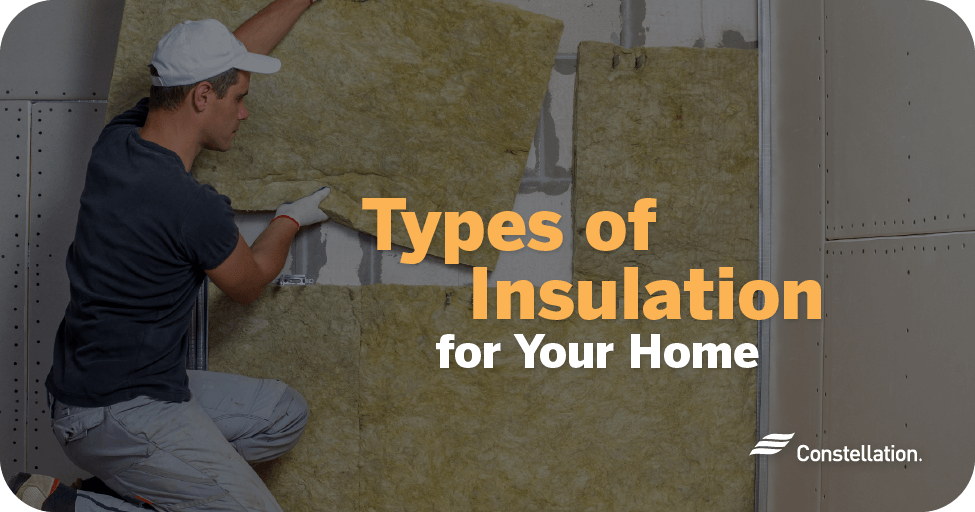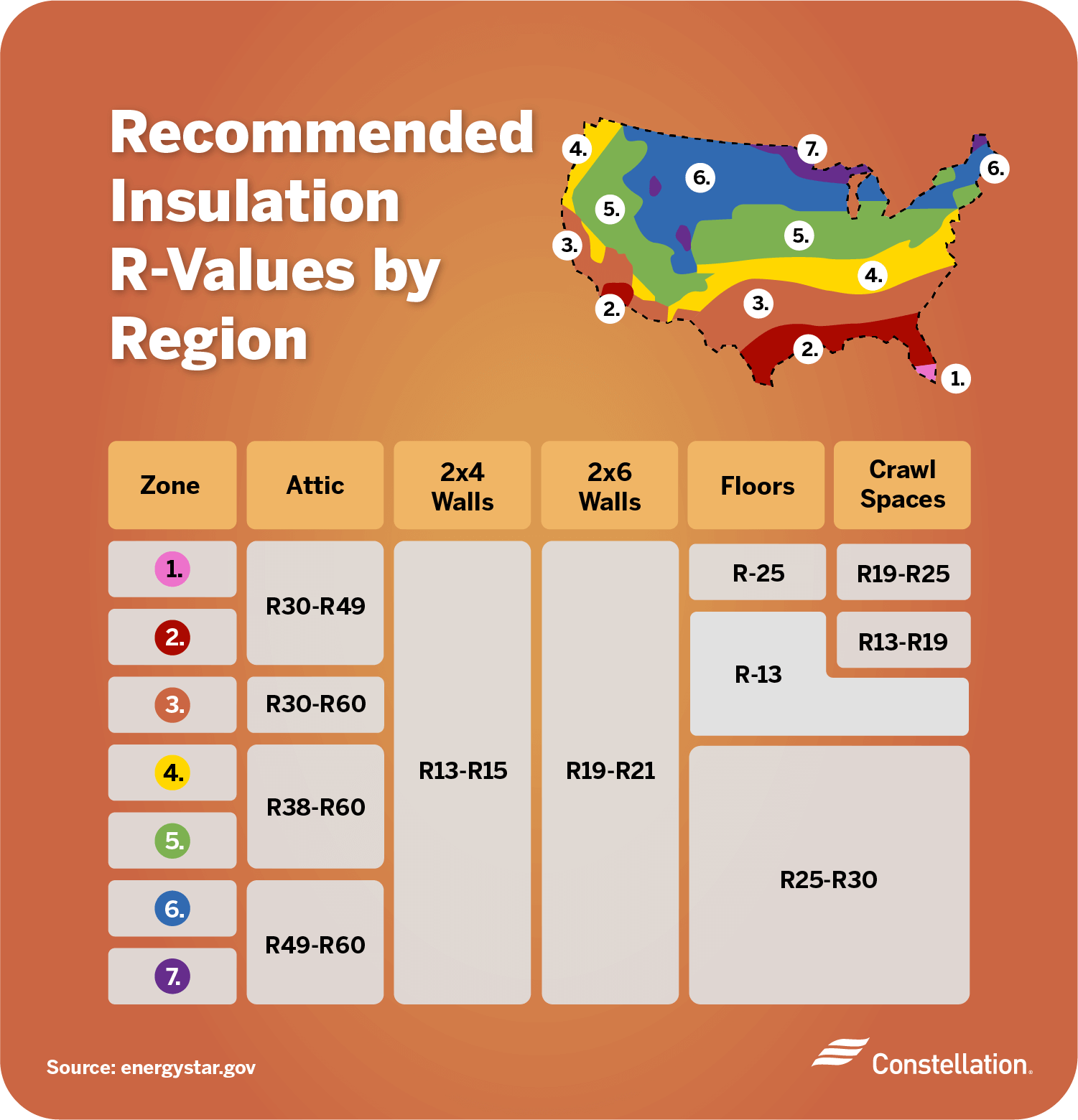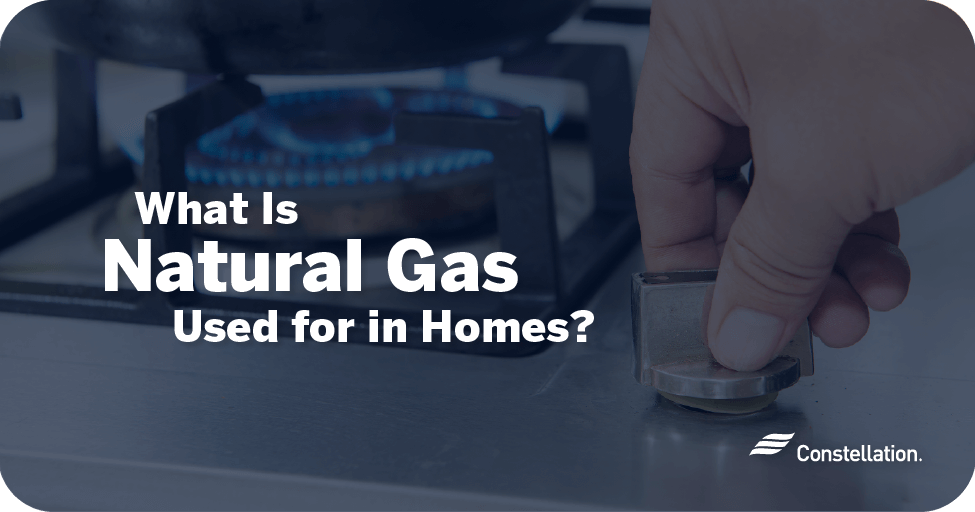
- Category:
Energy Efficiency - Published:
October 3, 2022 - Updated:
October 6, 2022
Types of Insulation for Your Home
Choosing among the insulation types available today can be challenging. Because home insulation is important to help make a home more comfortable and efficient, choosing the right types of insulation materials and installing them properly is vital.
The first step in choosing the right insulation types is understanding how insulation works. Essentially, you’re managing heat and moisture. Heat can escape your home in the winter and may find its way inside during the summer in a process called conduction. Some materials like metal easily conduct heat. Materials that are less dense with many air pockets conduct little heat and are ideal for insulation.
Moisture is important to a healthy and comfortable environment. Too much and you have a damp home prone to mold and pest infestation. Too little and you’ll suffer from a dry throat, eyes
and skin. Pairing insulation with a moisture or vapor barrier puts you in control of the proper level of humidity in your home.
With this understanding, here are common types of insulation that can improve the health, comfort and efficiency of heating and cooling your home:
- Structural Insulated Panels (SIPs)
- Radiant Barrier Insulation
- Vapor Barrier Insulation
- Insulated Concrete Forms
- Loose-Fill and Blown-In Insulation
- Foam Board or Rigid Foam
- Spray Foam and Foamed-In-Place Insulation
- Fiberglass Insulation
Factors to Consider When Picking Insulation for Your Home
The right type of home insulation depends on several factors. It is not a one-type-fits-all situation. Here are the most important considerations for choosing which type of insulation to put into your home.
What is the required R-value of your region?

R-value is the common way to measure insulation effectiveness. The bigger the number, the greater the insulation value. The R is for the resistance to the flow of heat through material. A wooden door has an R-value between 3 and 6. Common fiberglass batt insulation has an R-value of R-13.
What part of your home are you insulating?
You will want to use products best suited to the different areas of your home. Different types of insulation are specifically designed for certain conditions, such as moisture, compression and stresses, and radical changes in temperature. The shape and configuration of the area matter. Ease of installation is also a factor, with some types of insulation requiring the services of professionals.
How much insulation does your home need?
The amount of insulation your home needs depends on the materials used to build it and the amount of insulation you already have. Your general climate is something to keep in mind, as are the local conditions. If your home is on a hill with no trees, you’ll have different insulation needs than if your home is in a protected valley under a canopy of green. The last factor in making home insulation choices is your budget. While most insulation is relatively affordable, it can add up.
Types of Insulation Materials
The types of insulation materials available are vast and ever-increasing. Here, however, are the most popular and useful options:

Structural Insulated Panels (SIPs)
One innovative form of wall insulation is the structural insulated panel. This prefabricated material is made of a polystyrene foam sandwiched between boards. They fit together to form walls and floors when buildings are being constructed.
Pros:
- They create nearly airtight walls and floors for highly efficient insulation.
- The material is structurally superior to wood.
- The speed and simplified construction process may reduce costs.
- They allow for tremendous design versatility.
- They are less prone to pest infestation.
Cons:
- Moisture quickly damages this material, leading to wood rot, delamination, and degradation of its structural and insulating properties.
- The lifespan of 60 years mandates relatively frequent renovation.
- Once installed, making alterations is nearly impossible.
- Because the buildings are airtight, you need a very well-designed ventilation system.
- It takes an experienced contractor to properly install the material.
Radiant Barrier Insulation
Radiant barriers are made of materials that reflect heat. It is constructed of a foil-type material that, when facing inward, reflects heat back into your home or outward reflects heat away from your home reducing your air conditioning expenses.
Pros:
- The material is thin and lightweight, making it easy to install in a variety of places.
- It does not absorb moisture, so it does not breed mold.
- It is highly durable and will provide long-lasting insulation benefits.
- It is easy to install.
Cons:
- It does not stop convection, so cold will still penetrate your home. You will need to add to its radiant heat protection with traditional insulation.
Vapor Barrier Insulation
Vapor barriers help you manage humidity to maintain an environment that is neither too dry nor too wet. Metal, glass, rubber and certain plastics are nearly impermeable to water. Gypsum board and wood are less so. Controlling moisture is especially important with basement insulation but is also a consideration in roof insulation and wall insulation.
Pros:
- It is relatively easy to install.
- You can better protect pipes and electrical systems.
- Because concrete degrades in moist conditions, you can lengthen the life of your foundation.
- Prevent mold and deter pest infestations.
Cons:
- Improper installation can keep moisture in, creating an ideal environment for mold.
- For basements, the vapor barrier needs to be installed outside the slab, an expensive undertaking if you are retrofitting.
Insulated Concrete Forms
Your foundation is built using a framework or form into which concrete is poured. Usually the form is removed once the concrete cures; however, insulated concrete forms stay in place as a permanent way of insulating your basement.
Pros:
- Your foundation is more structurally sound than traditional ones.
- You use less concrete and reduce labor, saving money in construction.
- Concrete is protected during curing, reducing air bubbles and faults.
- It provides exceptional protection from moisture, protecting your foundation, your belongings, and your health.
Cons:
- They are not ideal for very cold climates.
- While construction costs are cheaper, the forms are more expensive than temporary throw-away forms.
- Construction is more complex and requires a trained, experienced crew.
Loose-Fill and Blown-In Insulation
Fluffy loose material, often made of cellulose or fiberglass, can be spread in your attic as roof insulation and in gaps for insulating new or existing walls. It adds a layer of insulation in new homes and is an energy-efficient home upgrade that helps you heat and cool your attic more efficiently.
Pros:
- It is efficient in filling gaps where heat can escape in walls and attics.
- You can layer in more insulation to increase protection from the weather.
- It is ideal for irregularly shaped areas.
Cons:
- Professional installation and specialized equipment are required.
- The process can be messy.
- The material is heavy and may cause ceilings to sag.
- It holds moisture, making the material prone to mold and fungus.
- It is very hard to remove.
- It can settle and lose R-value.
- It is expensive.
Foam Board or Rigid Foam
Expanded or extruded polystyrene boards have many applications as wall insulation, roof, insulation and as basement insulation. It resists water, making it resistant to mold. A third type, polyisocyanurate is often used in roof insulation due to its very high R-value.
Pros:
- All types have relatively high R-values.
- It is water resistant and with added foil or plastic facings it can function as a water barrier.
- In new construction, it is added to the exterior of the home, which eliminates the thermal bridging along metal or wooden studs.
Cons:
- It is a costly option.
- It is tricky to install, especially around odd shapes.
- It is not structurally sound, so it needs to be used with other materials
- Hydrochlorofluorocarbons (HCFCs), a known pollutant, are created during manufacturing and the material is not recyclable.
Spray Foam and Foamed-In-Place Insulation
Spray foam is an aerosol plastic injected into cracks and crevices, or across large areas of your ceilings and walls. You can use it to insulate windows to keep heat out. It expands before hardening in place. When fully cured, it creates an airtight seal for effective insulation, saving energy in winter and summer.
Pros:
- It is effective in blocking heat and moisture for excellent insulating performance.
- You may save energy with a highly efficient home.
- It works in nearly any application, especially hard-to-reach areas.
Cons:
- Spray foam is expensive.
- It can release dangerous fumes when on fire.
- Some people are sensitive to the chemicals in it.
- It must be professionally applied, adding to the cost.
Fiberglass Insulation
The most popular and widely used insulation, fiberglass typically comes in long rolls. The rolls can be placed between wall and ceiling studs and the floor joists in floors. It can be used in new or existing structures and comes in a variety of R-values.
Pros:
- This kind of insulation is inexpensive and effective.
- Fiberglass does not shrink.
- The material does not burn or emit fumes in a fire.
- It resists insect infestation.
Cons:
- Protective gear is necessary as slivers of fiberglass can penetrate the skin or be inhaled, creating painful conditions and serious health risks.
- Fiberglass insulation degrades when exposed to moisture.
- The batts do not tightly seal spaces and leave thermal bridges in the form of studs and joists.
- As the material ages, its R-value decreases.
Learn more home energy-saving tips from Constellation
Improving the insulation of your home could save energy and money. But don’t stop there. Our home energy savings articles offer more ways to cut your energy usage and potentially your bill.




